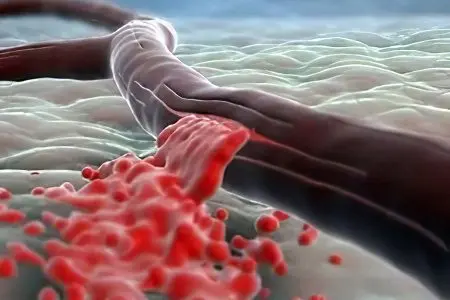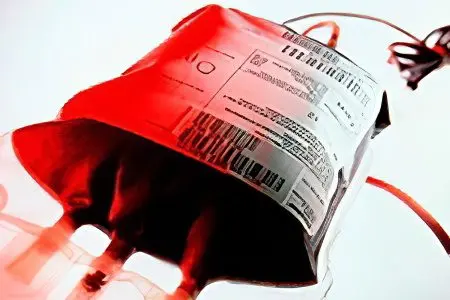Contents

Posthemorrhagic anemia is a complex of changes in the blood picture and in the state of the body as a whole, which develops against the background of acute or chronic blood loss.
Posthemorrhagic anemia is a life-threatening condition and is accompanied by symptoms such as: pale skin, severe shortness of breath, a sharp darkening in the eyes, a significant decrease in blood pressure. In severe cases, loss of consciousness and the development of a shock state are possible.
With posthemorrhagic anemia, the volume of blood circulating in the body is significantly reduced. In parallel, the level of erythrocytes in the blood falls. A wide variety of pathologies can lead to the development of this disorder: diseases of any internal organs, complicated by bleeding, wounds and injuries, and not only. The nature of anemia can be acute and chronic.
Long-term disturbance of hemodynamics in posthemorrhagic anemia leads to severe hypoxia of organ tissues with their further dystrophy. In severe cases, posthemorrhagic anemia can be fatal.
Reasons for the development of posthemorrhagic anemia

Acute hemorrhagic anemia develops as a result of acute blood loss. This happens with internal or external bleeding. It is characterized by massiveness and high speed. Damage to the vascular walls is most often mechanical in nature. Moreover, major blood vessels are affected. Also, acute posthemorrhagic anemia can be caused by bleeding from the cavities of the heart against the background of injuries or after undergoing surgical operations. Infarcts accompanied by rupture of the chambers of the heart walls, rupture of an aortic aneurysm, violation of the integrity of the pulmonary artery and its large branches – all this can cause acute blood loss with the further development of anemia. Other risk factors include: rupture of the spleen, damage to the integrity of the uterine appendage, for example, during the birth of life in it.
In general, any heavy bleeding from the uterine cavity, even with prolonged menstruation, can lead to the development of acute posthemorrhagic anemia. Dangerous in this regard are diseases of the digestive system, in particular, peptic ulcer of the stomach and duodenum.
In children during the neonatal period, posthemorrhagic anemia can also develop, which most often manifests against the background of birth injuries or placental bleeding.
Chronic posthemorrhagic anemia develops with the following disorders:
Insignificant, but regular bleeding in diseases of the digestive tract.
Frequent nosebleeds.
Bleeding hemorrhoids.
Periodic renal bleeding.
DIC and hemophilia. These conditions are characterized by a violation of the process of blood clotting.
Cancerous neoplasms: stomach cancer, cancer of the large and small intestine. In this case, tumors damage the integrity of organs and tissues, causing regular blood loss.
Leukemias, which are characterized by increased permeability of the vascular wall.
Radiation sickness that develops against the background of radioactive effects on the body. At the same time, violations of hemostasis and the development of posthemorrhagic anemia occur due to changes in the composition of the blood at the cellular level.
Vitamin C deficiency can lead to the development of anemia, accompanied by a decrease in the level of not only red blood cells, but also hemoglobin.
In terms of the development of chronic posthemorrhagic anemia, helminthic invasions are dangerous when large parasites stick to the walls of the intestine and damage them.
How posthemorrhagic anemia develops: pathogenesis and stages of formation

Risk factors that can increase the likelihood of developing posthemorrhagic anemia include:
Vascular insufficiency, in which the volume of circulating blood does not correspond to the capacity of the vascular bed. This happens either due to a decrease in vascular tone, or due to a decrease in blood volume.
Hypovolemia with a decrease in the volume of circulating plasma and red blood cells. As a result, the patient’s internal organs will suffer, experiencing acute hypoxia and ischemia. Shock may develop.
Depending on the rate of blood loss, as well as the amount of fluid leaving the body, the severity of adaptive mechanisms will depend.
In the first 24 hours after the onset of bleeding, the sympathetic-adrenal system is in a state of increased excitation. Peripheral vessels constrict, which causes more blood to flow to the brain and heart, with a decrease in cardiac output. During this period, which is called the reflex-vascular period, the level of red blood cells, hemoglobin and hematocrit are within normal limits. Such hemorrhagic anemia is called latent.
After 1-2 days, that is, on 2-3 days from the onset of bleeding, tissue fluid begins to enter the bloodstream, which allows the body to maintain a normal level of plasma in the blood. In parallel, the production of catecholamines and aldosterone (adrenal hormones), vasopressin (hypothalamus hormone) increases. These substances help to maintain a normal level of electrolytes in the blood plasma. The number of erythrocytes and hemoglobin, meanwhile, continues to decline, and the hematocrit falls. However, the color index of the blood remains within the normal range. This stage of hemorrhagic anemia is called hydremic.
Starting from the 4th day of bleeding, anemia becomes hypochromic. The kidneys tend to produce more erythropoietin. The red bone marrow “releases” a large number of reticulocytes (young red blood cells) and white blood cells. Hematocrit, hemoglobin and erythrocytes in the blood circulate in insufficient quantities. If during this period, which is called the bone marrow period, blood loss is stopped, then the level of blood cells will recover to its original values after 14-21 days. If this is not done, then all the adaptive mechanisms of the body will be exhausted, and the patient will develop a state of shock.
Symptoms of posthemorrhagic anemia

The longer and more abundant bleeding a person has, the more serious the symptoms of posthemorrhagic anemia will be.
If blood loss is acute, then this is expressed by the following symptoms:
Strong weakness.
Pale skin.
Pale mucous membranes.
The appearance of “flies” before the eyes, periodic darkness in the eyes.
Dizziness.
The appearance of noise in the ears.
Dryness in the mouth.
A drop in body temperature, which is especially noticeable in the upper and lower extremities.
Eruption of clammy and cold sweat.
Increased pulsation with a decrease in its strength.
Drop in blood pressure.
If bleeding develops in a child younger than a year old, then he will be much harder to bear than an adult.
If blood loss is plentiful, and blood is poured out of the vascular bed quickly, then the victim may develop a collapse. Hypotension will be extremely pronounced, the pulse is barely palpable, or may be absent altogether. Breathing becomes shallow, episodes of vomiting and convulsive seizures often occur. Human consciousness in most cases is absent.
Severe anemia can lead to death, which occurs against the background of acute hypoxia of the internal organs. The work of the heart and respiratory center stops.
Separately, it is necessary to designate the symptoms of chronic blood loss, in which mild anemia develops.
This is characterized by the following violations:
The skin becomes dry, cracks appear on it.
Any wounds on the skin heal for a very long time, they can fester.
The pallor of the skin and mucous membranes is not too pronounced, but it is difficult not to notice it.
Nails become brittle, exfoliate.
Hair grows dull, begins to fall out.
The heart works in an increased rhythm, which often goes astray.
Sweating increases.
Body temperature can remain at the level of subfebrile marks for a long time.
The patient often has ulcers in the mouth, possibly the formation of carious teeth.
Such symptoms are not clear and may disturb the patient from time to time. This is due to the fact that the body launches compensatory mechanisms and works at the peak of its capabilities. However, sooner or later, they will run out.
Diagnosis of posthemorrhagic anemia

Diagnosis of posthemorrhagic anemia begins with a survey of the patient’s complaints and with his examination. The doctor must measure the patient’s blood pressure, assess the nature of his mucous membranes and skin. If the doctor suspects that the patient has just such a diagnosis, he will send him to a series of examinations.
Lab tests will be as follows:
A blood test to determine the level of hemoglobin and red blood cells, which will be reduced.
Blood chemistry.
Urinalysis with control of its daily volumes.
Determination of the total volume of circulating blood.
Bone marrow puncture is performed only if the diagnosis remains in doubt. Be sure to establish the cause of posthemorrhagic anemia. To do this, an ultrasound examination of the internal organs and organs of the small pelvis, FGDS, colonoscopy, sigmoidoscopy, and an electrocardiogram are performed. Zheniny should visit the gynecologist.
How to treat?

The scheme of the therapeutic effect on the patient depends on what exactly caused the development of posthemorrhagic anemia. Detected bleeding should be stopped as soon as possible. If blood loss is caused by external bleeding, then a tourniquet or bandage is applied to the wound, it is possible to suture blood vessels and damaged tissues and organs. The victim must be urgently hospitalized.
If the blood loss is massive, then the following measures are indicated:
Transfusion of erythrocyte mass, plasma and plasma substitutes (Reopoliglyukin, Gemodez, Poliglukin). This measure must be taken promptly, as large blood loss is associated with a high risk of death.
Prednisolone (a hormonal drug) is administered when a patient develops a state of shock.
Solutions of albumin, glucose, saline – all these substances are administered to the patient intravenously to restore the salt balance in the body.
To replenish iron stores, injections of Sorbifer Durules or Ferroplex preparations can be used. However, it must be borne in mind that their use is associated with a high probability of an allergic reaction.
Severe anemia requires the introduction of significant doses of blood. Doctors call this procedure a blood transplant. If, after the restoration of the total blood volume, the patient’s blood pressure normalizes, and its qualitative composition improves, this indicates that the therapy was chosen correctly. To improve the patient’s well-being, he is prescribed vitamins of group B.
Symptomatic treatment should be aimed at restoring the work of the heart and blood vessels, brain, liver and kidneys, as well as other organs affected by hypoxia.
Delayed therapy involves the patient following a diet that is aimed at restoring the qualitative composition of the blood. To do this, you will need to consume red low-fat meat, liver, eggs, sour-milk drinks, vegetables and fruits, cottage cheese, fish. At least 2 liters of water should be drunk per day, rosehip broth is useful.
The more massive the volume of blood lost, the worse the prognosis for recovery. If at the same time a person loses? part of the total blood volume, then the likelihood of developing hypovolemic shock is extremely high. If blood loss equates to ? parts, the victim will not be able to survive. Provided that anemia develops with chronic blood loss, then most often it can be neutralized after the source of bleeding is found and eliminated.









